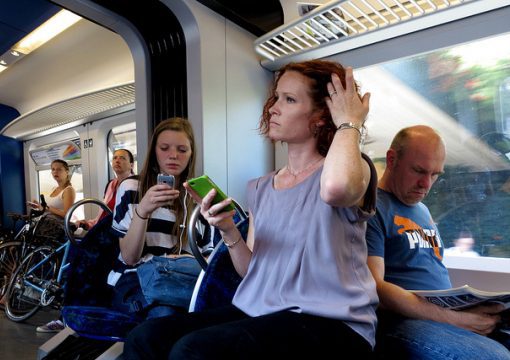How smart is your city, really?

TORONTO – Maybe the game-changer is 3-D printing. Or maybe it’s robotic cars and “autonomous driving,” an innovation that may well mean we’ll never again have to learn to parallel park. Maybe it’s “the Internet of everything” – the idea that sooner or later almost everything will be connected via the Internet.
It’s obvious big changes are coming to cities worldwide and to daily life. During last week’s “Meeting of the Minds” conference in Toronto, much of the talk was about “a smarter and more connected urban future.”
We heard of reinventions, “smart cities” and Big Data. Rogier van der Heide, chief design officer for Philips Lighting, mentioned “a thin layer of technology all over the city.” We heard from people who invented a way you can lay claim, online at least, to an area of your city and create social and information networks for anyone you admit into your network, all of whom presumably carry mobile devices that tell them the information you want them to have.
Already, some 13 billion devices worldwide are connected, said Wim Elfrink, chief globalization officer of Cisco Systems, who predicted that will soar to 50 billion by 2020. Yes, the Internet of Everything, indeed.
We heard about IBM’s Smarter Cities Challenge, making grants to 100 cities around the globe, “enabling cities to make transformational changes which have resulted in many new insights.” Turns out my own county (Mecklenburg) was one of the first to receive a Smart City Challenge, in 2010. Who knew? Read more about it by clicking here. (The key recommendation appears to have been this: “All local government entities, not just the Board of County Commissioners, should be at the table when decisions about capital projects are made.” Well, maybe things have improved, but if this is happening it is happening out of the public eye and it’s not being mentioned at City Council meetings. So does that make this a not-quite-smarter city?)
The techno-possibilities are intriguing, and as Sara Diamond, president of OCAD (Ontario College of Art and Design) University, put it, “Data is the oil and water of the 21st century.” Imagine the potential improvements, and the business possibilities, when you can mash-up information on everything from school test scores to traffic tie-ups to street lights to obesity rates to available parking places to the weather – and then make the information easily available. All while your car is parallel-parking itself, as you sit and file your nails.
Delivered seamlessly, these new ways to look at and manage the world will change us in ways we can’t foresee. After all, 15 years ago who’d have thought that text messages would be considered less intrusive, and a telephone call to a friend or business colleague would now be considered, by some, a rude interruption.
By midmorning my head was spinning with techno-geeky inventions and also with, well, spin. So these words were a welcome landing back down to earth:
“You hear a lot about smart cities,” said Environmental Protection Agency official Jared Blumenfeld. “Cities are not very smart.” His point was not to castigate cities, but to say that people who work in cities are no smarter than anyone else and unlike Lake Wobegon, not everybody is above average. “When you have technology which is crunching big data but you can’t fill a pothole, there’s a problem. Cities have to function at a very basic level.”
It was also valuable to hear plenty of references to the non-technical, non-wired tools people are still successfully using in the challenging work of improving and reinvigorating cities. MarySue Barrett, president of Chicago’s venerable, nonprofit Metropolitan Planning Council, described what she called their “secret sauce.” Her points:
- Focus simultaneously on both immediate and long-term solutions.
- Understand your metro region’s assets, so you can make the tough decisions about where to focus your efforts.
- “Partnerships, which I realize is a really tired, worn-out phrase.” Government, business and community groups must all be at the table, she said. “Don’t be satisfied to say, ‘Oh, we reached out and no one showed up.’ ”
And now I have a confession. As I sat there amid eager consumers of techno-miracles and attempted to simultaneously listen, Tweet and take coherent notes, I started wondering: Just because we can be even more tightly connected to information, is that really what we all want?
Tell the truth: Do you really want yet more information streaming at you? How many of us can drink from the fire hose we’re already slurping from, much less absorb more?
Yesterday, while writing this I decided I needed to clear my head from what often feels like more connectedness than I can manage. So I took a short break from my desk and walked across the university campus where I work to a nearby coffee shop. I went past blooming begonias and phlox. Tree leaves bobbled in a sunny breeze. I sipped a nicely brewed cappuccino. Near as I could tell the flowers, the trees, the coffee and the wind were not connected to any digital devices. And that was OK.
The question, I think, is how to make sure that as we swim in this ocean of information we make sure the Internet of Everything is just a tool we wield and doesn’t become our master. Is there any way to guarantee that unintended consequences don’t squander the opportunity before us? Or will our 3-D printers start spewing out pills promising enlarged body parts, or maybe printing fake money from fake Nigerian banks? What happens when a 14-year-old hacks into the car’s command center as it’s parallel-parking itself?
In other words, can we purposefully shape this era of connected data so that it truly improves human lives? That’s a challenge that will truly take a lot of Smarter Cities.
Views expressed in commentary articles here do not necessarily represent the views of the UNC Charlotte Urban Institute or the University of North Carolina at Charlotte.